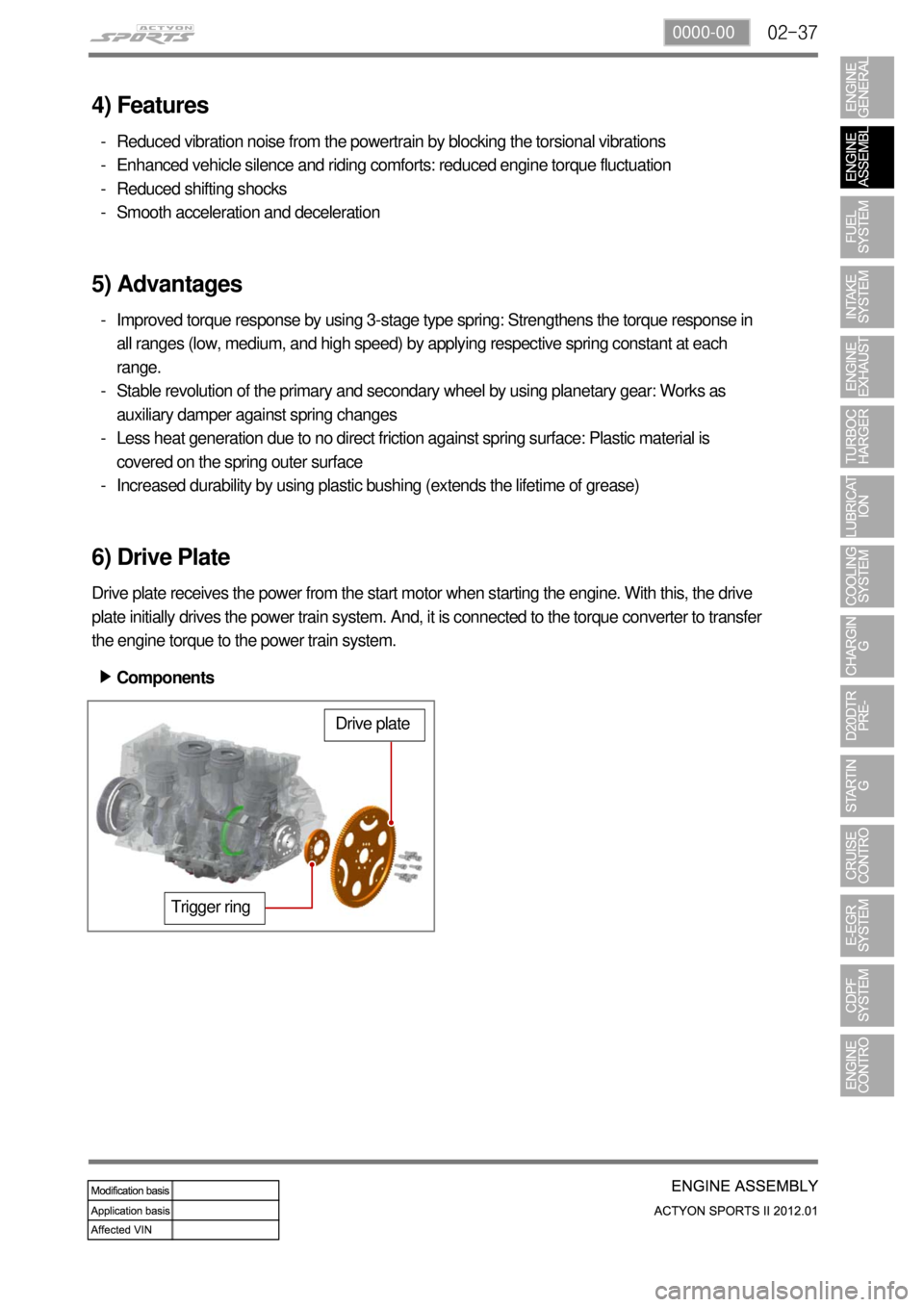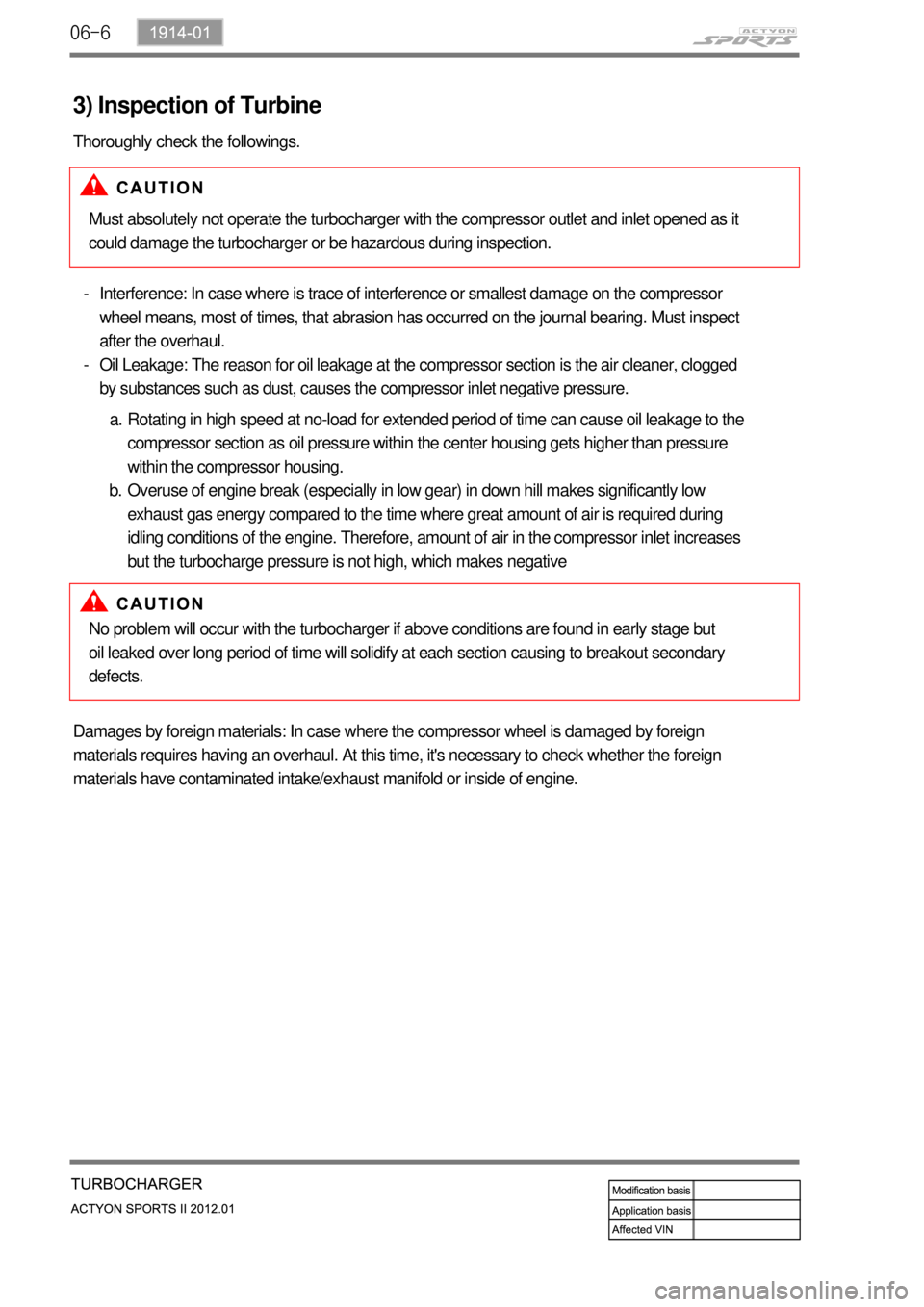wheel SSANGYONG NEW ACTYON SPORTS 2012 Service Manual
[x] Cancel search | Manufacturer: SSANGYONG, Model Year: 2012, Model line: NEW ACTYON SPORTS, Model: SSANGYONG NEW ACTYON SPORTS 2012Pages: 828, PDF Size: 91.28 MB
Page 112 of 828

02-30000-00
8910-26 Micro pole antenna
8320-01 Rear combination lamp
Side view
Sun roof (sun shade
panel: roller type)
Deck side panel Front
fender
Wheel
Side sill
Old
New
OldNew
Old
NewOldNew
Stop/Tail
lamp
Turn signal
lamp
Back-up lampStop/Tail
lamp
Turn signal
lamp
Back-up lamp
7820-22 Washer nozzle
Page 118 of 828

02-90000-00
1336-01 Timing gear case cover
Added the belt tension mounting boss
1130-01 Crankshaft assembly
- Reduced weight
- Deleted ring gear
1130-18 Drive plate assembly (A/T)
Changed the location of torque converter
mounting hole1130-13 Dual mass flywheel
Deleted centering sleeve
1115-02 Engine mounting bracket
D20DTR (Actyon Sports)
OldNew
OldNew
OldNew
Old
New
OldNew
with center bearingwithout center
bearing
Page 133 of 828

01-12
1. SPECIAL SERVICE TOOLS
Name & Part number Tool How to use (on vehicle)
Part number: T99410010A
Name: Belt tension adjuster
Use to release tension
without removing belt when
replacing pulley or pump.
How to use (on engine)
Part number: T9941 0010A
Name: Flywheel fixing device
Use to fix flywheel or drive
shaft to prevent engine from
rotating when removing
crankshaft pulley
Page 141 of 828

02-4
2. TIGHTENING TORQUE
Component SizeBolt
QuantitySpecified torque
(Nm)Remark
(Total torque)
Main bearing capM12×8210 55±5Nm,
180˚Not re-usable
Connecting rod capM9×52840±5Nm,
90˚+10˚50 to 80 Nm
Rear coverM6×20610 ± 1 Nm-
Oil pumpM8×35SOC325 ± 2.5 Nm-
FlywheelM10×22845 ± 5 Nm,
90˚+10˚60 to 100 Nm
Crankshaft center boltM20×851200 ± 20 Nm,
180˚+20˚660 to 720 Nm
Not re-usable
Oil panM6×201810 ± 1 Nm-
M6×35210 ± 1 Nm-
M6×85210 ± 1 Nm-
M6×120210 ± 1 Nm-
M8×40225 ± 2.5 Nm-
HP pump main nutM14×1.5-8-1165 ± 5 Nm-
HP pump boltM8×55325 ± 2.5 Nm-
Cylinder headM13×15012 85Nm
270°±10°-
Camshaft capM6×301610 ± 1 Nm -
M8×60425 ± 2.5 Nm -
Exhaust stud bolt 1015±1.5Nm-
Exhaust sprocket boltM11×40130 ± 3 Nm -
Chain tensioner screw
boltM38×1.5 125±2.5Nm -
Coolant temperature
sensor120±2.0Nm -
Auto tensionerM8×30(LOW) 125±2.5Nm -
M10×75(Upper) 155±5.5Nm -
Coolant pumpM6×50 110±1.0Nm -
Page 172 of 828

02-350000-00
9. DUAL MASS FLYWHEEL (DMF) & DRIVE PLATE
1) Overview
Flywheel is installed on crankshaft. When
starting the engine, this functions as follows:
Reducing the irregular speed of crankshaft
due to unbalanced combustion ->
Improving the power train NVH, Improving
the driving performance
Reducing the clutch noise by using ball
bearing
Improving the durability of DMF by using
strong arch spring -
-
-
2) Layout
Spring guide
Drive plate
Primary cover
Primary flywheel
Internal/external ringSecondary flywheel
Ring gear
Page 173 of 828

02-36
Torque change curve of engine and drive shaft
Compression stroke Combustion stroke
Small changes from engine (k):
Damper increases the torque changes to clutchLarge changes from engine (j):
Damper decreases the torque changes to
transaxle by absorbing the impact
3) Operation
Compensating the irregular operation of engine: The secondary flywheel operates almost
evenly so does not cause gear noises
The mass of the primary flywheel is less than conventional flywheel so the engine irregularity
increases more (less pulsation absorbing effect).
Transaxle protection function: Reduces the torsional vibration to powertrain (transaxle) by
reducing the irregularity of engine. -
-
-
Page 174 of 828

02-370000-00
4) Features
Reduced vibration noise from the powertrain by blocking the torsional vibrations
Enhanced vehicle silence and riding comforts: reduced engine torque fluctuation
Reduced shifting shocks
Smooth acceleration and deceleration -
-
-
-
5) Advantages
Improved torque response by using 3-stage type spring: Strengthens the torque response in
all ranges (low, medium, and high speed) by applying respective spring constant at each
range.
Stable revolution of the primary and secondary wheel by using planetary gear: Works as
auxiliary damper against spring changes
Less heat generation due to no direct friction against spring surface: Plastic material is
covered on the spring outer surface
Increased durability by using plastic bushing (extends the lifetime of grease) -
-
-
-
6) Drive Plate
Drive plate receives the power from the start motor when starting the engine. With this, the drive
plate initially drives the power train system. And, it is connected to the torque converter to transfer
the engine torque to the power train system.
Trigger ring
Drive plate
Components ▶
Page 225 of 828

06-50000-00
2) Inspection of Turbocharger
When problem occurs with the turbocharger, it could cause engine power decline, excessive
discharge of exhaust gas, outbreak of abnormal noise and excessive consumption of oil.
On-board Inspection 1.
Check the bolts and nuts foe looseness or missing
Check the intake and exhaust manifold for looseness or damage
Check the oil supply pipe and drain pipe for damages
Check the housing for crack and deterioration -
-
-
-
Inspection of turbine 2.
Remove the exhaust pipe at the opening of the turbine and check, with a lamp, the existence of
interference of housing and wheel, oil leakage and contamination (at blade edge) of foreign
materials.
Interference: In case where the oil leak sign exists, even the small traces of interferences on
the turbine wheel mean, most of times, that abrasion has occurred on the journal bearing.
Must inspect after overhauling the turbocharger.
Oil Leakage: Followings are the reasons for oil leakage condition -
-
Idling for long period of time can cause oil leakage to the turbine side due to low pressure of
exhaust gas and the rotation speed of turbine wheel. Please note this is not a turbocharger
problem.
Oil Drain Pipe Defect
In case where oil flow from the turbocharger sensor housing to the crank case is not smooth
would become the reason for leakage as oil builds up within the center housing. Also, oil
thickens (sludge) at high temperature and becomes the indirect reason of wheel hub section. In
such case, clogging and damage of the oil drain pipe and the pressure of blow-by gas within
the crank case must be inspected.
Damages due to Foreign Materials
When the foreign materials get into the system, it could induce inner damage as rotating
balance of the turbocharger gets out of alignment. -
-Problems in engine: In case where the oil is smeared on inner wall section of the exhaust
gas opening.
Problems in turbocharger: In case where the oil is smeared on only at the exhaust gas
outlet section. *
*
Page 226 of 828

06-6
3) Inspection of Turbine
Thoroughly check the followings.
Must absolutely not operate the turbocharger with the compressor outlet and inlet opened as it
could damage the turbocharger or be hazardous during inspection.
Interference: In case where is trace of interference or smallest damage on the compressor
wheel means, most of times, that abrasion has occurred on the journal bearing. Must inspect
after the overhaul.
Oil Leakage: The reason for oil leakage at the compressor section is the air cleaner, clogged
by substances such as dust, causes the compressor inlet negative pressure. -
-
Rotating in high speed at no-load for extended period of time can cause oil leakage to the
compressor section as oil pressure within the center housing gets higher than pressure
within the compressor housing.
Overuse of engine break (especially in low gear) in down hill makes significantly low
exhaust gas energy compared to the time where great amount of air is required during
idling conditions of the engine. Therefore, amount of air in the compressor inlet increases
but the turbocharge pressure is not high, which makes negative a.
b.
No problem will occur with the turbocharger if above conditions are found in early stage but
oil leaked over long period of time will solidify at each section causing to breakout secondary
defects.
Damages by foreign materials: In case where the compressor wheel is damaged by foreign
materials requires having an overhaul. At this time, it's necessary to check whether the foreign
materials have contaminated intake/exhaust manifold or inside of engine.
Page 231 of 828

06-111914-01
3. TROUBLESHOOTING
The followings are cautions to take in handling defects of turbocharger, which must be fully aware
of.
1) Cautions
After stopping the engine, check whether the bolts on pipe connecting section are loose as
well as the connecting condition of vacuum port and modulator, which is connected to the
actuator.
During idling of the engine, check for leakage in the connecting section of pipe (hoses and
pipes, duct connections, after the turbocharger) by applying soap water. The leakage
condition in the engine block and turbine housing opening can be determined by the
occurrence of abnormal noise of exhaust.
By running the engine at idle speed, abnormal vibration and noise can be checked.
Immediately stop the engine when abnormal vibration and noise is detected and make
thorough inspection whether the turbocharger shaft wheel has any damages as well as
checking the condition of connections between pipes.
In case where the noise of engine is louder than usual, there is possibility of dampness in the
areas related with air cleaner and engine or engine block and turbocharger. And it could affect
the smooth supply of engine oil and discharge.
Check for damp condition in exhaust gas when there is sign of thermal discoloration or
discharge of carbon in connecting area of the duct.
When the engine rotates or in case where there is change in noise level, check for clogging of
air cleaner or air cleaner duct or if there is any significant amount of dust in the compressor
housing.
During the inspection of center housing, inspect inside of the housing by removing the oil
drain pipe to check for sludge generation and its attachment condition at shaft area or turbine
side.
Inspect or replace the air cleaner when the compressor wheel is damaged by inflow of foreign
materials.
Inspect both side of the turbocharger wheel after removing inlet and outlet pipe of the
turbocharger. 1.
2.
3.
4.
5.
6.
7.
8.
9.